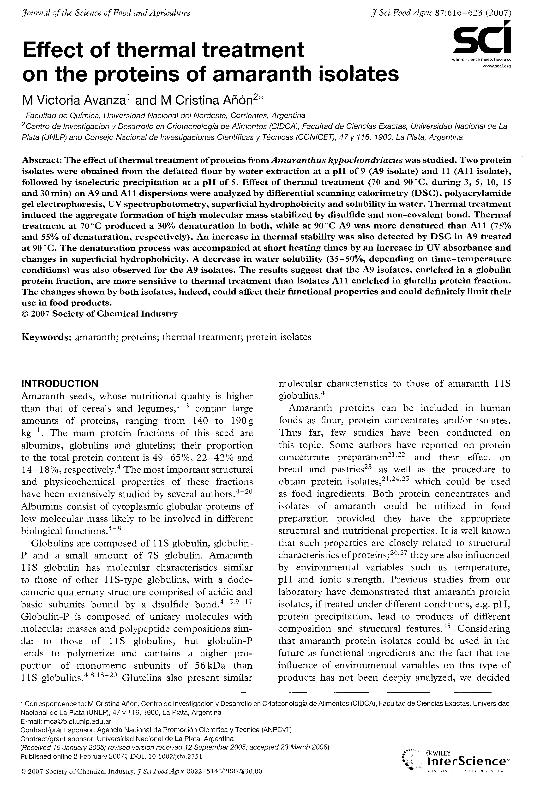Mostrar el registro sencillo del ítem
dc.contributor.author
Avanza, María Victoria

dc.contributor.author
Añon, Maria Cristina

dc.date.available
2020-08-11T19:23:10Z
dc.date.issued
2007-03
dc.identifier.citation
Avanza, María Victoria; Añon, Maria Cristina; Effect of thermal treatment on the proteins of amaranth isolates; John Wiley & Sons Ltd; Journal of the Science of Food and Agriculture; 87; 4; 3-2007; 616-623
dc.identifier.issn
0022-5142
dc.identifier.uri
http://hdl.handle.net/11336/111466
dc.description.abstract
The effect of thermal treatment of proteins from Amaranthus hypochondriacus was studied. Two protein isolates were obtained from the defatted flour by water extraction at a pH of 9 (A9 isolate) and 11 (A11 isolate), followed by isoelectric precipitation at a pH of 5. Effect of thermal treatment (70 and 90 °C, during 3, 5, 10, 15 and 30 min) on A9 and A11 dispersions were analyzed by differential scanning calorimetry (DSC), polyacrylamide gel electrophoresis, UV spectrophotometry, superficial hydrophobicity and solubility in water. Thermal treatment induced the aggregate formation of high molecular mass stabilized by disulfide and non‐covalent bond. Thermal treatment at 70 °C produced a 30% denaturation in both, while at 90 °C A9 was more denatured than A11 (75% and 55% of denaturation, respectively). An increase in thermal stability was also detected by DSC in A9 treated at 90 °C. The denaturation process was accompanied at short heating times by an increase in UV absorbance and changes in superficial hydrophobicity. A decrease in water solubility (35–50%, depending on time–temperature conditions) was also observed for the A9 isolates. The results suggest that the A9 isolates, enriched in a globulin protein fraction, are more sensitive to thermal treatment than isolates A11 enriched in glutelin protein fraction. The changes shown by both isolates, indeed, could affect their functional properties and could definitely limit their use in food products.
dc.format
application/pdf
dc.language.iso
eng
dc.publisher
John Wiley & Sons Ltd

dc.rights
info:eu-repo/semantics/openAccess
dc.rights.uri
https://creativecommons.org/licenses/by-nc-sa/2.5/ar/
dc.subject
Amaranth
dc.subject
Proteins
dc.subject
Thermal treatment
dc.subject
Protein isolates
dc.subject.classification
Alimentos y Bebidas

dc.subject.classification
Otras Ingenierías y Tecnologías

dc.subject.classification
INGENIERÍAS Y TECNOLOGÍAS

dc.title
Effect of thermal treatment on the proteins of amaranth isolates
dc.type
info:eu-repo/semantics/article
dc.type
info:ar-repo/semantics/artículo
dc.type
info:eu-repo/semantics/publishedVersion
dc.date.updated
2020-07-20T20:20:42Z
dc.identifier.eissn
1097-0010
dc.journal.volume
87
dc.journal.number
4
dc.journal.pagination
616-623
dc.journal.pais
Reino Unido

dc.journal.ciudad
Londres
dc.description.fil
Fil: Avanza, María Victoria. Universidad Nacional del Nordeste; Argentina
dc.description.fil
Fil: Añon, Maria Cristina. Provincia de Buenos Aires. Gobernación. Comisión de Investigaciones Científicas. Centro de Investigación y Desarrollo en Criotecnología de Alimentos. Consejo Nacional de Investigaciones Científicas y Técnicas. Centro Científico Tecnológico Conicet - La Plata. Centro de Investigación y Desarrollo en Criotecnología de Alimentos. Universidad Nacional de La Plata. Facultad de Ciencias Exactas. Centro de Investigación y Desarrollo en Criotecnología de Alimentos; Argentina
dc.journal.title
Journal of the Science of Food and Agriculture

dc.relation.alternativeid
info:eu-repo/semantics/altIdentifier/url/https://onlinelibrary.wiley.com/doi/abs/10.1002/jsfa.2751
dc.relation.alternativeid
info:eu-repo/semantics/altIdentifier/doi/http://dx.doi.org/10.1002/jsfa.2751
Archivos asociados
